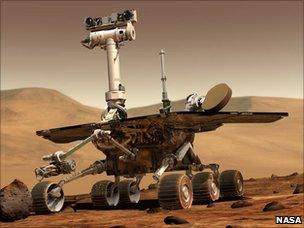Nasa says Spirit rover unlikely to call home
- Published

The Mars rovers were designed with the expectation that they would work for at least three months
The incredible Martian adventure of Nasa's Spirit rover is at an end.
Engineers have conceded they are unlikely ever to hear from the vehicle again and are ceasing attempts to make contact with it.
Spirit got stuck in soft sand in May 2009 and sent its last communication to Earth some 14 months ago.
The robot geologist's mission has been an astonishing success. Its rock studies have shed new light on the Red Planet's wetter and warmer past.
But the US space agency (Nasa) has accepted it has virtually no chance of receiving more data from the rover.
A transmission that will end on Wednesday will be the last in a series of attempts to re-establish communications.
Spirit's position in the sandtrap has meant its solar panels have not been ideally angled to ensure adequate energy is available to run its survival heaters, especially during Mars' harsh winters.
Dust on the panels is thought to have further compromised their efficiency. It is probable that extreme cold has damaged many critical components and connections on the robot.
Water story
Spirit was one of two rovers that Nasa landed on Mars in the January of 2004, with the design expectation that they would work for at least three months. Amazingly, the second vehicle, Opportunity, continues to roll across the surface of the Red Planet today.
Spirit was targeted at the 170km-wide Gusev Crater, a near-equatorial location in the southern hemisphere that orbital images had suggested might once have held a giant lake.
The investigation of this watery history got off to a slow start, with Spirit eventually finding rocks that had undergone very limited alteration by exposure to moisture.
It was only after a 2.5km drive to nearby hills that the instrumented robot discovered rocks and soils that had experienced extensive contact with water.
Nasa intends now to put its exploration efforts into preparing for the forthcoming mission of its Curiosity-Mars Science Laboratory (MSL) rover, which is due to launch at the end of the year.
"We're now transitioning assets to support the November launch of our next generation Mars rover, Curiosity," said Dave Lavery, programme executive for Solar System exploration.
"However, while we no longer believe there is a realistic probability of hearing from Spirit, the Deep Space Network may occasionally listen for any faint signals when the schedule permits."
Still rolling
The Opportunity rover is working in a region known as the Meridiani Plains. This is halfway around the planet and closer to the equator, and so does not have quite the same temperature issues as those faced by Spirit.
Opportunity is showing its age but still looks to have quite a bit of life left in it. Engineers are now driving the robot in reverse to help prolong its gearboxes by allowing their teeth to wear on the opposite side.
Opportunity's robot arm - the device it uses to reach out to interesting rocks - is increasingly "arthritic". One of its joints no longer works properly.
A number of the robot's instruments are also worn and prone to glitches.
But scientists say Opportunity continues to return valuable data.
The robot is trying to get to the 22km-wide Endeavour Crater.
The impact which made this bowl has exposed ancient rocks. The expectation is that they will contain clay minerals that were formed 4-4.5bn years ago in long-standing, neutral water - the sort of conditions that might also have supported microbial life.
- Published7 April 2011